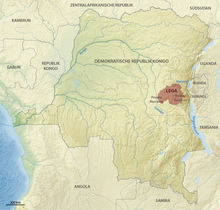Lega people

Location of the Lega people in the Democratic Republic of the Congo
|
|
| Total population | |
|---|---|
| 250,000 | |
| Regions with significant populations | |
| Languages | |
| Lega language |
The Lega people (or Warega) are an ethnic group of the Democratic Republic of the Congo. In 1998 their population was about 250,000.
By the 1970s the Lega people were mostly living in the middle and upper Elila valley and the upper Ulindi River valley. These rivers both rise in the east of South Kivu and flow in a northwesterly direction through Maniema, joining the Lualaba downstream from Kindu. The upper Ulindi valley has a richly diverse fauna, including many monkey species, chimpanzees, leopards, buffaloes, elephants and antelopes. The valley is administratively divided into the Mwenga and Shabunda territories of South Kivu Province and the Pangi Territory of Maniema Province.
The territory is covered by deep rain forest and, in the east, rugged mountains rising to 6,000 feet (1,800 m) or more. The climate is hot and humid year round. Average temperature is 75 °F (24 °C) to 80 °F (27 °C). Annual rainfall is 60 inches (1,500 mm) to 80 inches (2,000 mm). The mountains hold areas of moist woodlands as well as montane forest and grasslands. To the north and west the forest is denser and deeper. The south of the region holds mosaics of forest savannah and woodlands. All of the forest has long been inhabited by humans, who have cleared land for cultivation, then let it return to the wild. In some places the forest has not grown back but has been replaced by grassland. The forest has many plants and trees that provide food and are used for other purposes, and has abundant wildlife.
The Lega people traditionally live in small village groups, with no central authority. Within a community, a chief inherits his position on a patrilineal basis, and his close relatives have highest rank. Counterbalancing this hereditary structure, the Bwami society also regulates social and political life. This society has seven levels for men and four for women and is open to all. An initiate advances through the ranks through a complex system of instruction, payment and initiation, achieving increasing status. A member of the highest level is recognized as a Kindi, a social leader with great moral authority.
...
Wikipedia
